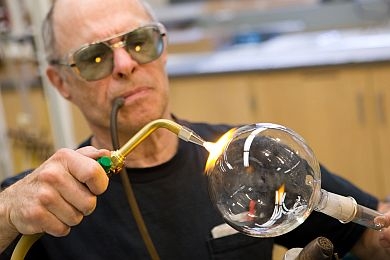
Roy Wentz
When University of Michigan glassblower Harald Eberhart hears President Barack Obama call for more research on fuel cells, batteries, solar and wind power, it fills him with hope-and with dread. Energy research-just about any research, really-means business will be picking up for the men and women who craft molten glass into the one-of-a-kind widgets and whatzits of science.
More work, but for fewer and fewer glassblowers.
Eberhart and fellow U-M glassblower Roy Wentz produce custom scientific glassware for U-M's School of Engineering and chemistry department, respectively. That could mean anything from a flameless catalytic heater made to produce heat in Antarctica to a Schlenk line-an intricate piece of equipment that lets chemists run experiments with oxygen-sensitive chemicals.
Even in this age of ever-improving technology and materials, some things simply require glass.
Scientists like that it's transparent and doesn't contaminate their samples. In the hands of a master glassblower it can take almost any form-lenses, containers, valves, connectors, thick slabs and thin films.
"Say you wanted something spherical, but with essentially no weight," said chemistry professor Rick Francis, who's also associate dean for budget in the college of LSA. "You'd go on the web, and you could advertise, but I don't think you'd find anything you could purchase. You need not just a glassblower, but one that knows the tricks of the trade, who knows how thin you can blow the glass. Some of this stuff is Byzantine in its complexity."
Glass made from quartz can go from a 2,000-degree-Celsius propane/oxygen flame to a beaker of cold water without breaking. Because it can withstand those extremes quartz researchers use quartz containers to change materials from solid to liquid to gas. All computer chips are made in quartz tubes because quartz is the only material that can handle the heat without contaminating its contents.
Under compression, glass is stronger than steel.
"People think glass is fragile," Eberhart said. "But I can make glass so hard you can pound a nail into a piece of wood with it."
Read the full story by Amy Whitesall. Reprinted with permission of Michigan Today."